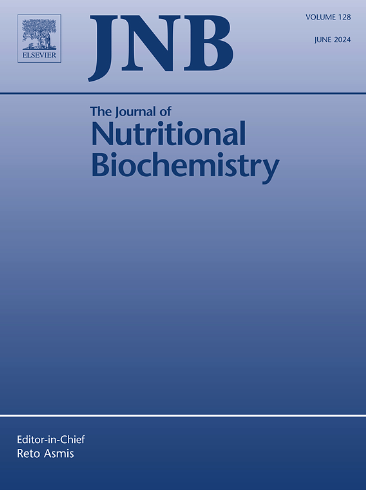口服 PIISVYWK 和 FSVVPSPK 肽可减轻高脂饮食诱导的肥胖小鼠的肥胖、氧化应激和炎症反应。
IF 4.8
2区 医学
Q1 BIOCHEMISTRY & MOLECULAR BIOLOGY
引用次数: 0
摘要
从蓝贻贝中提取的生物活性肽 PIISVYWK (P1) 和 FSVVPSPK (P2),在对抗肥胖、氧化应激和炎症方面具有显著功效。这项研究表明,这些肽通过下调致脂肪转录因子过氧化物酶体增殖激活受体γ(PPARγ)、CCAAT/增强子结合蛋白α(C/EBPα)和固醇调节元件结合蛋白1(SREBP-1),抑制骨髓间充质干细胞(BMMSCs)向脂肪细胞的分化。此外,P1 和 P2 还能通过激活 AMP 激活蛋白激酶(AMPK)和激素敏感性脂肪酶(HSL)来减少脂肪生成和促进脂肪分解。这些肽还能减少脂肪生成过程中细胞内活性氧(ROS)的生成,抑制丝裂原活化蛋白激酶(MAPK)通路,从而减轻炎症反应。血红素加氧酶-1(HO-1)参与了这一机制,因为抑制 HO-1 会逆转这些效应。在体内,高脂饮食(HFD)肥胖小鼠口服 P1 和 P2 可防止体重增加,减少脂肪组织堆积,降低脂肪生成和脂肪生成生物标志物,改善血清胆固醇水平,促进脂肪分解,减少促炎细胞因子的产生。这些研究结果表明,P1和P2肽可通过激活HO-1/核因子红细胞2相关因子2(Nrf2)途径,有效预防肥胖和相关代谢紊乱。本文章由计算机程序翻译,如有差异,请以英文原文为准。
Oral administration of PIISVYWK and FSVVPSPK peptides attenuates obesity, oxidative stress, and inflammation in high fat diet-induced obese mice
The bioactive peptides PIISVYWK (P1) and FSVVPSPK (P2), derived from the blue mussel Mytilus edulis, exhibit significant benefits in combating obesity, oxidative stress, and inflammation. This study demonstrates that these peptides inhibit the differentiation of bone marrow-derived mesenchymal stem cells (BMMSCs) into adipocytes by downregulating the adipogenic transcription factors peroxisome proliferator-activated receptor gamma (PPARγ), CCAAT/enhancer-binding protein alpha (C/EBPα), and sterol regulatory element-binding protein 1 (SREBP-1). Furthermore, P1 and P2 reduce lipogenesis and enhance lipolysis through the activation of AMP-activated protein kinase (AMPK) and hormone-sensitive lipase (HSL). These peptides also decrease intracellular reactive oxygen species (ROS) generation during adipogenesis and inhibit the mitogen-activated protein kinase (MAPK) pathway, thereby reducing inflammation. The involvement of heme oxygenase-1 (HO-1) in this mechanism is confirmed by the reversal of these effects upon HO-1 inhibition. In vivo, oral administration of P1 and P2 in high-fat diet (HFD) obese mice prevents weight gain, reduces adipose tissue accumulation, lowers adipogenic and lipogenic biomarkers, improves serum cholesterol levels, enhances lipolysis, and decreases pro-inflammatory cytokine production. These findings suggest that P1 and P2 peptides may effectively prevent obesity and related metabolic disorders by activating the HO-1/nuclear factor erythroid 2-related factor 2 (Nrf2) pathway.
求助全文
通过发布文献求助,成功后即可免费获取论文全文。
去求助
来源期刊

Journal of Nutritional Biochemistry
医学-生化与分子生物学
CiteScore
9.50
自引率
3.60%
发文量
237
审稿时长
68 days
期刊介绍:
Devoted to advancements in nutritional sciences, The Journal of Nutritional Biochemistry presents experimental nutrition research as it relates to: biochemistry, molecular biology, toxicology, or physiology.
Rigorous reviews by an international editorial board of distinguished scientists ensure publication of the most current and key research being conducted in nutrition at the cellular, animal and human level. In addition to its monthly features of critical reviews and research articles, The Journal of Nutritional Biochemistry also periodically publishes emerging issues, experimental methods, and other types of articles.
 求助内容:
求助内容: 应助结果提醒方式:
应助结果提醒方式:


